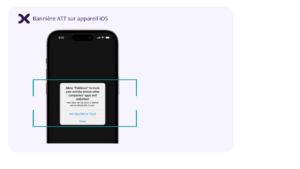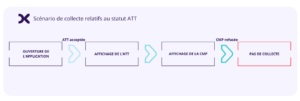The Impact of App Tracking Transparency on Data Collection

Mehdi Shahin has been a senior Analytics & Conversion consultant at Converteo for 4 years. He is an expert in Data & Analytics on web and mobile applications. He supports clients on tracking issues and data reconciliation between online and offline to ensure value-driven management.
Key takeaways:
- App Tracking Transparency (ATT) was introduced with the iOS 14.5 update in April 2021.
- ATT introduces a mandatory pop-up window that conditions data collection; this pop-up is independent of the CMP and tends to significantly reduce user consent rates.
- This drop in consent rates leads to a decrease in measured traffic and complicates performance management as well as the deployment of A/B testing, often falling below 10%.
- ATT only concerns applications that collect the IDFA. Therefore, it is possible to adapt measurement strategies by deploying solutions that do not use the IDFA.
- Not retrieving the IDFA helps maintain a reasonable consent rate, not excessively impacting data collection and usage; however, it makes the use of media SDKs impossible. This action is worthwhile if ATT dramatically affects the consent rate.
- Consent rates can drop below 25% due to ATT, making the utilization of analytics and media data challenging.
Regulations and best practices surrounding data collection are constantly evolving. The introduction of Apple’s App Tracking Transparency (referred to as ATT) marked a turning point in the management of iOS mobile application data. The purpose of this article is to clarify the concept of ATT, what is expected from application publishers, and its impact on data utilization.
Definitions:
- ATT: App Tracking Transparency is an advertising tracking control mechanism implemented by Apple with the iOS 14.5 update in April 2021. This mechanism encourages publishers to be more transparent about the use of collected data sent to third parties.
To understand the impact of ATT, it is essential to comprehend what IDFA (Identifier for Advertisers) is.
- IDFA: IDFA is a unique advertising identifier for each user associated with the App Store. Users can choose to reset it or even disable it.
This advertising identifier is used to track the effectiveness of mobile app campaigns and for retargeting purposes. It is generally sent to third-party tools, analytics, and media platforms.
Mechanism of ATT and Impact
Functioning:
ATT appears as a pop-up generated by the phone. It requests the user’s consent for data collection upon the first launch of the application.
This pop-up explicitly asks whether the user allows the application to track their activity within the app.
This banner is not an alternative to the CMP banner, which is necessary for collecting data in compliance with CNIL regulations. ATT must be implemented in addition to the CMP and presented first in the user journey.
Moreover, if ATT is refused by the user, the CMP banner should not be displayed, as Apple considers that consent cannot be requested after an explicit refusal. Therefore, a refusal of ATT is regarded as equivalent to a refusal of CMP.

This banner, being generated by the phone, is not customizable, either in design or wording. Its relatively alarming nature is therefore very detrimental to the consent rate of an application. Since ATT must precede any consent request for data collection, there are three possible scenarios:
Scenario 1: The user gives their consent in the ATT banner and then consents in the company’s CMP banner.
The data will be collected and usable

Scenario 2: The user gives their consent in the ATT banner but refuses to give their consent in the company’s CMP banner.
The data must not be collected

Scenario 3: The user does not give their consent in the ATT banner, so their consent is not requested.
The CNIL consent is not even requested from the user

Despite its name, App Tracking Transparency (ATT) is not technically designed to prevent analytics tracking. According to Apple’s documentation, ATT specifically targets the collection of data for media and retargeting use cases.
For this reason, the deployment of ATT is only necessary if solutions present on the application collect the IDFA.
Alternatives & Recommendations
User Awareness:
Although it is not possible to customize the ATT pop-up since it is generated by the device, it is possible to trigger the ATT after an initial screen aimed at educating the user about data collection. This first screen can help reassure the user, potentially increasing the acceptance rate of ATT.
Adapt the Technical Stack:
The drop in consent rates due to ATT can be drastic, making data utilization impossible. In such cases, it may be advisable to remove solutions that rely on IDFA. This allows for a reasonable consent rate without triggering ATT.
This adjustment restores access to analytics data collection for performance measurement and enables significant-volume experimentation campaigns. However, it results in the loss of media use cases, which may not have been feasible anyway due to low consent rates.
An alternative is to use a consent-exempted analytics solution, which would maintain analytics tracking regardless of ATT status, thus preserving full performance data collection while allowing for partial media data collection.
For example, consent tied to ATT can drop below 10%, making data utilization impossible, whereas a CMP consent rate of 60% to 75% is generally achievable.

